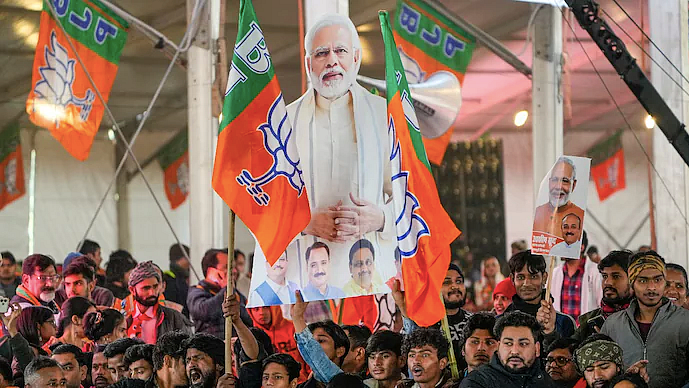
Delhi Elections: BJP's Main Problem is Disconnect With Key Demographic Groups
BJP struggles to connect with Delhi voters amid demographic changes and AAP's growing influence.

advertisement
The Bharatiya Janata Party (BJP) has been at a crossroads in Delhi politics since it lost power in 1998. In 2022, the BJP even ended up squandering the consolation of controlling the Municipal Corporation of Delhi (MCD). In the upcoming Assembly elections, the BJP is hoping to reverse its electoral drubbings in the national capital.
The BJP, indeed, has swept the last three Lok Sabha elections in Delhi. But the pendulum swings to the extreme opposite in the Assembly polls. This is despite the fact that the BJP in Delhi had three key faces with ‘Vijay’ in their names – Vijay Kumar Malhotra, Vijay Goel, and Vijendra Gupta.
The BJP's main problem lies in the alienation of key demographic groups. There's a need to go back in history to understand this.
Sheila Dikshit’s Fatal Blows to Delhi BJP
Leaders from BJP's Delhi unit have used the time out of power to introspect possible reasons for losing touch with the people. They concur that the social engineering of former Delhi Chief Minister Sheila Dikshit condemned the BJP to the status of a perennial Opposition party in the city.
Late Sheila Dikshit was a Purvanchali, as she claimed the Uttar Pradesh legacy by virtue of her marriage. She also remained a Punjabi at heart - her maiden name was Sheila Kapoor and was born in Kapurthala. In the course of the 15-year-long rule of the Congress in Delhi, the BJP went on to earn an image of a party of Punjabis and Baniyas.
Arvind Kejriwal Replaces Sheila Dikshit
The 2013 Delhi Assembly elections began the shift of the Congress vote base to the Aam Aadmi Party (AAP). The Purvanchalis and the middle class voters of Delhi found a convenient replacement of late Sheila Dikshit in Arvind Kejriwal.
The growing economic stress for the people in Delhi in the aftermath of the 2008 global financial meltdown warmed them up for scaling up the extent of subsidy programmes. They wanted more from the government, and Kejriwal whetted their appetites. By the 2015 Assembly elections, the Congress vote bank majorly shifted to the AAP. The Grand Old Party, which had ruled the city for 15 years, now found its vote share below 10 percent.
Delhi BJP Remains Clueless to Demographic Drift
The BJP, in contrast, remained stranded in the city politics. From the 2008 Assembly elections to the 2020 city polls, the BJP has polled in the range of 32 to 38.51 per cent vote shares. The best poll performance of the BJP in Delhi came when the party was headed by Manoj Tiwari in the 2020 Assembly elections.
In fact, Tiwari was seeking the BJP ticket from Buxar Lok Sabha seat in Bihar in 2014 when senior party leader Ashwani Kumar Choubey advised him to shift base to Delhi and play the Purvanchali card. But the marginal gains proved too little for commanding vote share in excess of 50 per cent of the AAP.
BJP Counts Sikh Voters’ Losses
If the Purvanchali disconnect was not enough, the BJP invited the wrath of the Sikh voters in Delhi. The BJP leaders blame wrong decisions such as ignoring veterans like Harsharan Singh Balli, a minister in the Madan Lal Khurana Cabinet in Delhi.
The BJP leaders argue that the decision to deny a ticket to Balli in the 2013 Assembly elections from Hari Nagar in Delhi cost the party dearly. The BJP lost all the Assembly seats in West Delhi where Sikh voters are influential.
The Sikh vote base in a big way shifted to the AAP in West Delhi after the 2013 Assembly elections. The BJP already writes score chart with minus 14 per cent to account for the Muslim votes. Then Sikh and Purvanchali voters also remained cold to the party's overtures.
BJP Sticks to Emotional Cards Despite Losses
The BJP’s Rohingya card in Delhi failed to ring the voters even while the party initially tried repeating Jharkhand-like campaign around Bangladeshi illegal immigrants.
In Delhi, the BJP is once more facing a regional party in Assembly elections close on the heels of loss to the Jharkhand Mukti Morcha (JMM)-led alliance.
The JMM and the AAP have are similar in some ways - both leaders have led their governments with a strong thrust on welfarism. The BJP on the other hand is without a template to connect with the people in Delhi in a manner that can significantly alter the electoral arithmetic.
BJP Candidate Selection is a Continuation of Old Politics
The ascendency of Congress under Sheila Dikshit and subsequently Arvind Kejriwal's AAP were on account of the two parties nourishing a fresh crop of leaders. The AAP took special care in politically empowering Purvanchalis and Sikhs in ticket distribution.
The BJP in contrast struggles to unyoke from politics of dynasty in Delhi. Two former CMs’ sons Harsh Khurana and Parvesh Saheb Singh Verma are contesting the elections. New Delhi Lok Sabha seat MP Bansuri Swaraj is daughter of late Sushma Swaraj (she was also Delhi CM briefly).
(The author is a senior Delhi-based journalist, who in his over two-decade long career worked for The New Indian Express, The Asian Age, Deccan Chronicle, and The Statesman. This is an opinion piece and the views expressed above are the author’s own. The Quint neither endorses nor is responsible for the same.)
- Access to all paywalled content on site
- Ad-free experience across The Quint
- Early previews of our Special Projects
Published: undefined